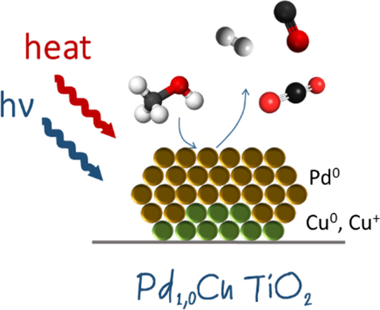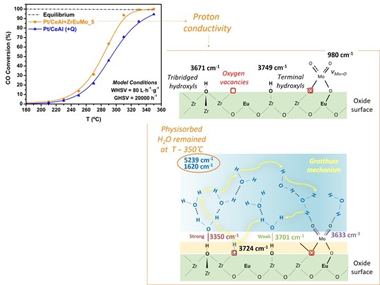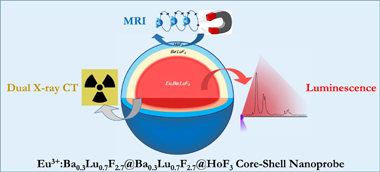Scientific Papers in SCI
2020
2020
Química de Superficies y Catálisis
Bimetallic PdAu catalysts for formic acid dehydrogenation
Santos, JL; Leon, C; Monnier, G; Ivanova, S; Centeno, MA; Odriozola, JAInternational Journal of Hydrogen Energy, 45 (2020) 23056-23068
Show abstract ▽
A series of monometallic and bimetallic palladium gold catalyst were prepared and studied for the formic acid dehydrogenation reaction. Different Pd/Au compositions were employed (PdxAu100-x, where x = 25; 50 and 75) and their impact on alloy structure, particle size and dispersion was evaluated. Active phase composition and reaction parameters such as temperature, formic acid concentration or formate/formic acid ratio were adjusted to obtain active and selective catalyst for hydrogen production. An important particle size effect was observed and related to Pd/Au composition for all bimetallic catalysts.
September, 2020 | DOI: 10.1016/j.ijhydene.2020.06.076
Propiedades mecánicas, modelización y caracterización de cerámicos avanzados
Disclination dipoles are the Holy Grail for high temperature superplasticity in ceramics
Moshtaghioun, BM; Bejarano-Palma, JA; Garcia, DGScripta Materialia, 185 (2020) 21-24
Show abstract ▽

A model for high-temperature plasticity of polycrystals controlled by disclination dipoles is proposed that predict a parabolic dependence of the strain rate versus the applied stress. The presence of a precise stationary disclination density explains the origin of plasticity without microstructural invariance, commonly known as superplasticity. The disclination mechanism is universal, although other processes, such as dislocation glide, are superposed to this one in many systems such as metals or metallic alloys. While, in ceramics it is likely to be the only operative mechanism. Activation of disclination dipoles is a necessary condition for plasticity and sufficient one for superplastic yielding.
August, 2020 | DOI: 10.1016/j.scriptamat.2020.03.049
Materiales y Procesos Catalíticos de Interés Ambiental y Energético
Thermo-Photocatalytic Methanol Reforming for Hydrogen Production over a CuPd-TiO2 Catalyst
Lopez-Martin, A; Platero, F; Caballero, A; Colon, GChemPhotoChem, 4 (2020) 630-637
Show abstract ▽

A bimetallic CuPd/TiO2 system has been prepared by a two-step synthesis and was used for a methanol steam photoreforming reaction. By sequential deposition, palladium is deposited over copper nanoclusters through a galvanic replacement process. Hydrogen production by steam reforming from methanol was achieved by both thermo-photocatalytic and photocatalytic processes. It appears that H-2 production on the bimetallic system is notably higher than the Pd monometallic reference. Moreover this difference in the catalytic performance could be related to the higher CO evolution observed for the monometallic Pd-1.0 TiO2 system which is partially inhibited in the bimetallic catalyst. In addition, an important thermal effect can be envisaged in all cases. Nevertheless, this improved effect in the thermo-photocatalytic process is accompanied by a remarkable CO evolution and SMSI effect (important strong metal-support interactions) that hindered the efficiency as temperature increases. On this basis, optimal operational conditions for H-2 production are obtained for thermo-photocatalytic reforming at 100 degrees C, for which the synergetic effect is higher with lower CO production (H-2/CO=4)
August, 2020 | DOI: 10.1002/cptc.202000010
Química de Superficies y Catálisis
Elucidation of Water Promoter Effect of Proton Conductor in WGS Reaction over Pt-Based Catalyst: An Operando DRIFTS Study
Jurado, L; Garcia-Moncada, N; Bobadilla, LF; Romero-Sarria, F; Odriozola, JACatalysts, 10 (2020) 841
Show abstract ▽

A conventional Pt/CeO2/Al(2)O(3)catalyst physically mixed with an ionic conductor (Mo- or Eu-doped ZrO2) was tested at high space velocity (20,000 h(-1)and 80 L h(-1)g(cat)(-1)) under model conditions (only with CO and H2O) and industrial conditions, with a realistic feed. The promoted system with the ionic conductor physically mixed showed better catalytic activity associated with better water dissociation and mobility, considered as a rate-determining step. The water activation was assessed by operando diffuse reflectance infrared fourier transformed spectroscopy (DRIFTS) studies under reaction conditions and the Mo-containing ionic conductor exhibited the presence of both dissociated (3724 cm(-1)) and physisorbed (5239 cm(-1)) water on the Eu-doped ZrO(2)solid solution, which supports the appearance of proton conductivity by Grotthuss mechanism. Moreover, the band at 3633 cm(-1)ascribed to hydrated Mo oxide, which increases with the temperature, explains the increase of catalytic activity when the physical mixture was used in a water gas shift (WGS) reaction.
August, 2020 | DOI: 10.3390/catal10080841
Materiales Coloidales
Design of a nanoprobe for high field magnetic resonance imaging, dual energy X-ray computed tomography and luminescent imaging
Gonzalez-Mancebo, D; Becerro, AI; Corral, A; Garcia-Embid, S; Balcerzyk, M; Garcia-Martin, ML; de la Fuente, JM; Ocana, MJournal of Colloid and Interface Science, 573 (2020) 278-286
Show abstract ▽

The combination of different bioimaging techniques, mainly in the field of oncology, allows circumventing the defects associated with the individual imaging modalities, thus providing a more reliable diagnosis. The development of multimodal endogenous probes that are simultaneously suitable for various imaging modalities, such as magnetic resonance imaging (MRI), X-ray computed tomography (CT) and luminescent imaging (LI) is, therefore, highly recommended. Such probes should operate in the conditions imposed by the newest imaging equipment, such as MRI operating at high magnetic fields and dual-energy CT. They should show, as well, high photoluminescence emission intensity for their use in optical imaging and present good biocompatibility. In this context, we have designed a single nanoprobe, based on a core-shell architecture, composed of a luminescent Eu3+:Ba0.3Lu0.7F2.7 core surrounded by an external HoF3 shell that confers the probe with very high magnetic transverse relaxivity at high field. An intermediate, optically inert Ba0.3Lu0.7F2.7 layer was interposed between the core and the shell to hinder Eu3+-Ho3+ cross-relaxation and avoid luminescence quenching. The presence of Ba and Lu, with different K-edges, allows for good X-ray attenuation at high and low voltages. The core-shell nanoparticles synthesized are good potential candidates as trimodal bioprobes for MRI at high field, dual-energy CT and luminescent imaging.
August, 2020 | DOI: 10.1016/j.jcis.2020.03.101
- ‹ previous
- 95 of 410
- next ›














